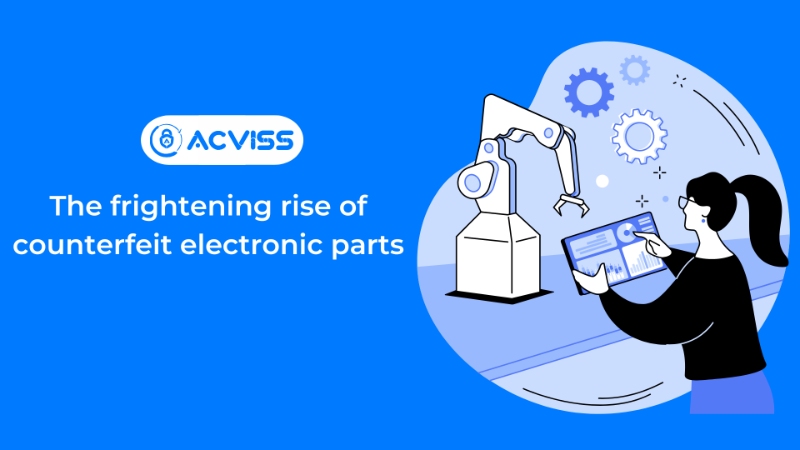The Frightening Rise of Counterfeit Electronic Spare Parts Industry

The electronic industry has been plagued by counterfeiters. A trend that has been on an alarming rise posing a life-threatening danger. Counterfeit parts are made with substandard materials and components causing them to be unreliable and prone to damage a large device or system. But the terrifying fact is that they are increasingly difficult to detect which has resulted in a rising worry in the manufacturing of electronics parts. These products can fail without warning, endangering the lives of the users and the expensive equipment they work with. But the counterfeiting in the electronics market is not limited to the threat to the users and manufacturers, it leaves a giant hole in the economy as well. Indian government lose a whopping Rs 1.17 trillion every year due to counterfeits. With the growth in the global electronics market, the risk posed by counterfeit parts flags a looming threat for manufacturers and consumers.
Fake Parts Can Lead to Dangerous Failures.
Counterfeit electronics parts can be among any equipment, from medical equipment to aerospace components. Malfunctions of these parts can cause fire or explosion which can risk the lives of the customers or people associated with the product. Unveiling the truth about the grave threat. But it is not just the people who are affected, the companies lose a fortune from repair costs and recall expenses. In 1997, a defective electrical component caused a plane to crash in Indonesia which caused the death of 234 people on board. This affirms the reason for using quality-assured parts from trusted companies.
However, the counterfeit market thrives due to the producer's profitability. Manufacturers often use low-quality components rather than authentic ones, which then they sell as the real ones. Technological advancements have made it highly possible for manufacturers to imitate authentic products without fail. Counterfeiters are becoming more clever at evading detection. The popularizing of 3D printing and computerised design software has opened new possibilities for them to mimic the original effortlessly. An estimated $1.8 trillion worth of counterfeit electronics roams the market, being passed onto innocent consumers and endangering lives.

India Leads the Counterfeit Market
The problem of electronic counterfeits In India is particularly severe. India has the highest prevalence of counterfeiting in the world, with 40-70% of products in certain markets believed to be fake. This number is particularly alarming given India’s rising dependence on electronics and computer systems, which are especially susceptible to counterfeiting due to the complexity of the manufacturing process and the high demand for components. This is why businesses in India need to take all necessary precautions to protect themselves against counterfeiting.
There are ways to spot fake parts, but it can be difficult.
When it comes to spotting fake electronic parts, it’s not an easy task. In many cases, the counterfeits are nearly impossible to tell apart from the original parts. Fortunately, there are some ways to identify the fakes.
One of the first signs of a fake part is if the part has a different label than what is usually found on the genuine version. Additionally, you should pay attention to any discrepancies between the physical attributes of the part. If there are any irregularities, it could indicate a counterfeit.
The second way to spot a counterfeit part is to check for the presence of the original manufacturer’s logo or serial number. If these identifying marks are missing, it could be a sign that the part is not genuine. Furthermore, you can also look at the electrical characteristics of the part. If they are different from what is listed in the manufacturer's specifications, then it is a red flag
Finally, if you have any doubts about a part, you can always contact the manufacturer directly and ask for verification of authenticity. The manufacturer should be able to provide you with a confirmation of the genuinity and if not, then it is likely that the part is a counterfeit.
Overall, it can be difficult to spot fake parts due to the sophisticated methods used by counterfeiters. However, by being aware of these methods and understanding the signs of a counterfeit part, you can ensure that your electronic components are genuine and safe to use. You can also minimise the risk of using counterfeit parts by only buying from trusted and reputable sources. Make sure to verify the credibility of online sellers before making a purchase.
Third-Party Safety Testing
Get your safety to the next level by taking advantage of third-party testing services that detect counterfeit components. These services will thoroughly test each piece before certifying its authenticity and ensuring that it meets all safety regulations. Following these steps and maintaining vigilance against counterfeiting can reduce the chances of buying a fake component. Doing so will guarantee that your products remain safe and reliable while keeping consumers satisfied and avoiding potential litigation down the line.
Companies should also take necessary precautions such as verifying suppliers' certifications and testing incoming shipments for quality control measures. Moreover, companies should invest in technologies such as ultraviolet marking which can help verify component authenticity.
Acviss Brand Protection
Acviss offers an unassailable solution for it. Employing blockchain systems and the use of advanced machine learning and AI tools, we track and trace each product from raw materials to its end users, through which the supply chain is safeguarded from any fraudulent activities.
Get in touch with our experts to learn more about implementing complete security to your brand in the online and offline channels with 100% visibility into the supply chain.
